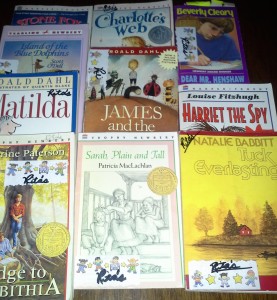
 Once kids start reading on their own, you can’t beat Captain Underpants or other fun books. But today I’m talking about classic core literature, time-tested beloved junior novels, which always delight and make you think. By second or third grade you can start moving into family friendly novels from early reader or short chapter books.
Once kids start reading on their own, you can’t beat Captain Underpants or other fun books. But today I’m talking about classic core literature, time-tested beloved junior novels, which always delight and make you think. By second or third grade you can start moving into family friendly novels from early reader or short chapter books.
Parents, it’s important to keep reading long past toddler time. The 20 minutes a day pleasure reading goal is a good baseline. But why not add in another 20 minutes to read a chapter a day of a novel, as a family? You can even sneak in a mini-lesson.
First, look at this recent Scholastic study about the importance of continuing reading to children past toddler years. Not surprising, 91% of parents read aloud weekly, to under six year old kids. Yet, only 54% read aloud to 0-5 aged children, five to seven days a week. This declines to 34%, 6-8 year olds, and only 17%, 9-11 year olds. What do you think about this? And what can we do about it?
I suggest you read and share a family novel a month. Yes, it’s possible. Even with busy schedules, you can read after dinner or during “stolen moments”. While anthologies and excerpts are ok, it’s far better to read entire books. Take turns reading out loud, summarize what’s happening, share feelings and connect with other favorite books.
My favorite Junior novels, time-tested but still relevant (by title, author, grade):
- Matilda: (Roald Dahl) (varies, 3-5)
- Stone Fox: (Gardiner) (2-4 grades)
- Charlotte’s Web: (E.B, White) (2 plus)
- James and the Giant Peach: (Roald Dahl) (3-8)
- Tuck Everlasting: (Natalie Babbitt) (grades 5-8)
- Dear Mr. Henshaw: (Beverly Cleary) (grades 5-6)
- Sarah, Plain and Tall: (Patricia MacLachlan) (2-4)
- Island of the Blue Dolphins: (Scott O’Dell) (Varies 4-8)
- Bridge to Terabithia: (Katherine Patterson) (4-6 grade or older)
- Harriet The Spy: (Louise Fitzhugh) (grades 4-6 or older)
- Hatchet (and The River): (Paulsen) (Varies, 4-9)
- Number The Stars: (Lois Lowry) (varies, 5-8)
The most important goal is to read great literature as a family tradition. A secondary benefit, you model the building blocks of basic novel reading strategies. Here are suggestions to choose from.
- Plot: This book’s about. It begins with; the middle part is about; here’s what happens at the end.
- Story Grammar: Who? Where? When? What? Fix it. 1.Who are the main characters? 2.Where does the story take place? 3.When does the story take place? 4. What is the problem (Oops!). 5. Fix it. How do the characters resolve the problem?
- Sequence: Storyboard map- Fold a piece of paper into 6 boxes. First, Next, Next, Then, Then, Finally! OR make a sequence chart: record first, next, then, and finally. EASY, hold up a finger for each of the steps or stages.
- Setting: Before reading: Where do you think the story takes place? During reading: Has the setting changed, or is it the same? Before and during: When does the story take place? (day, season, month or year?) After reading: Describe the various settings, if there were any changes in the book. Thank about it: How does the setting add to the story? Would this story be different in a different setting? Draw the setting.
- Character: Make a basic web, or circle with 7 spokes. In the middle circle, write the character. Spokes include: How old; Looks like; Family; Friends with; Says Things Like; Acts Like; Problems is?
- Make Predictions: Use this frame out loud, or written: Guess what it’s about. “I think that it’s about: Read it. “I was right”. I wasn’t right.” I was sort of right.” Make another guess. “I think that”. Read again. Continue this process until you’ve finished the chapter or book.
- Figurative Language : Start with basic comparisons: (metaphors) and similes (like, as).
- Summarize: Combine with retellings, summarize often, keeping the flow of the story. Make 8 box folds out of paper. Or fold into sixteen boxes. Use as many boxes as needed to summarize each paragraph, page or chunk. Write one short summary in each box.
- Vocabulary: Pick out the best new vocabulary in each chapter. Make lists, or index cards defining the word. Practice spelling and using the new word.
Classroom teachers encourage pleasure reading at home. I’m suggesting for only twenty minutes a day, turn everything off and read some classic adolescent literature. Family classic reading time will be a fondly remembered tradition! Leaving footprints on your reading hearts.
Follow me on Twitter and like me on Facebook!
